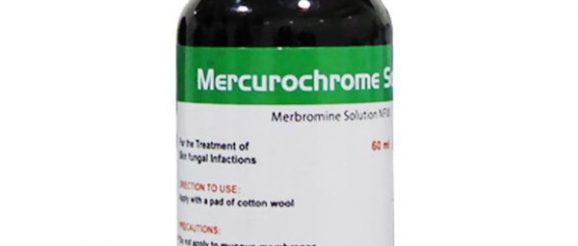The use of Mercurochrome – Innovation Chasers Blog

Mercurochrome is a 2% aqueous merbromin solution that acts as an antiseptic against Gram-positive and Gram-negative bacteria and other organisms. Mercurochrome tincture is an antiseptic solution, nothing more than diluted merbromin dissolved in alcohol, acetone, or water. The solution in the form of Mercurochrome is standard in medical cabinets. Mercurochrome is mercury in a disodium salt, which is considered completely harmless.
 Mercurochrome is a brand name for the chemical merbromine, which contains mercury and bromine as its active components. It is a water-based antiseptic, making it less likely to sting the wound than alcohol-based antiseptics like Merthiolate and iodine.
Mercurochrome is a brand name for the chemical merbromine, which contains mercury and bromine as its active components. It is a water-based antiseptic, making it less likely to sting the wound than alcohol-based antiseptics like Merthiolate and iodine.
Merbromin is a topical antiseptic used to treat minor cuts and scrapes. The deep red color of the ointment stains the skin when applied to a wound. It had been widely helpful as a household antiseptic ointment. The antibacterial characteristics of the antiseptic are effective, especially for children – because it does not sting or irritate the skin when applied.
Mercurochrome and other mercury-based antiseptics slowed the spread of bacteria but did not kill them; once washed away, the bacteria were free to spread. Furthermore, Mercurochrome to the wound dyed the skin red, making infection more difficult to detect. Merthiolate is another antiseptic containing mercury.
Merbromin is a powerful anti-replication agent for the Zika virus (ZIKV). The antiseptic disrupts the cell division process and inhibits the growth of cells for the virus to multiply.
It is an organomercuric disodium salt compound and fluorescein available in many countries, excluding Switzerland, France, Germany, and the United States, where the medicine is not available for sale due to the risk of mercury poisoning.
Betadine is a common antiseptic widely used has a long-lasting antiseptic effect due to its slow absorption by tissues, making it a suitable choice in surgeries. At the same time, Mercurochrome is a topical antiseptic also useful for antisepsis of the umbilical cord. It is also helpful for antisepsis of wounds in neuropathic ulcers and diabetic foot sores. The banning of Mercurochrome due to mercury poisoning makes betadine a safe drug to use during the wound healing process and the most common drug found everywhere.
Doctors do not recommend the application of Mercurochrome as it delays the healing of wounds. In contrast, Betadine is more effective for the mortality rate of microorganisms and is a home remedy to prevent wound infection. Mercurochrome interferes with the healing of the wound as it gives a stingy sensation. Merbromin is a combination of mercury and bromine, and it is lethal if swallowed.
The symptoms of side-effects of includes –
Mercurochrome is unsafe and not approved by the official regulatory body in the US. Extensive skin peeling with bullous lesions, edema, and fever developed three days after therapy. After this, there has been a restriction on selling the drug in the US since 1998.
